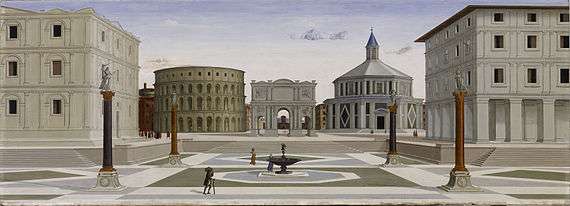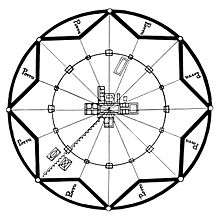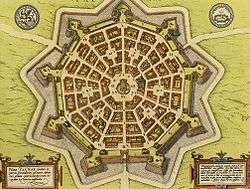Ideal city
An ideal city is the concept of a plan for a city that has been conceived in accordance with a particular rational or moral objective.

Concept
The "ideal" nature of such a city may encompass the moral, spiritual and juridical qualities of citizenship as well as the ways in which these are realised through urban structures including buildings, street layout, etc. The ground plans of ideal cities are often based on grids (in imitation of Roman town planning) or other geometrical patterns. The ideal city is often an attempt to deploy Utopian ideals at the local level of urban configuration and living space and amenity rather than at the culture- or civilisation-wide level of the classical Utopias such as St Thomas More's Utopia.
History

Several attempts to develop ideal city plans are known from the Renaissance, and appear from the second half of the fifteenth century. The concept dates at least from the period of Plato, whose Republic is a philosophical exploration of the notion of the 'ideal city'. The nobility of the Renaissance, seeking to imitate the qualities of Classical civilisation, sometimes sought to construct such ideal cities either in reality or notionally through a reformation of manners and culture.
Examples

Examples of the ideal cities include Filarete's "Sforzinda", a description of which was included in Trattato di architettura (c. 1465). The city of Sforzinda was laid out within an eight-pointed star inscribed within a circular moat. Further examples may have been intended to have been read into the so-called "Urbino" and "Baltimore" panels (second half of the fifteenth century), which show classically influenced architecture disposed in logically planned piazzas.

The cities of Palmanova and Nicosia, whose Venetian Fortesses were built in the 1590s by the Venetian Republic, are considered to be practical examples of the concept of the ideal city.[2] Another notable example of the concept is Zamość in eastern Poland, founded in the late 16th century and modelled by the Italian architect Bernardo Morando.
James Oglethorpe synthesized Classical and Renaissance concepts of the ideal city with new Enlightenment ideals of scientific planning, harmony in design, and social equality in his plan for the Province of Carolina. The physical design component of the famous Oglethorpe Plan remains preserved in the Savannah Historic District.[3]
Late nineteenth-century examples of the ideal city include the Garden city movement of Sir Ebenezer Howard, realised at Letchworth Garden City and Welwyn Garden City in England. Poundbury, Prince Charles' architectural vision established in Dorset, is among the most recent examples of ideal city planning.
Built in 1950s Nowa Huta in Kraków, Poland, serves as an unfinished example of a Utopian ideal city.
See also
References
- Centre, UNESCO World Heritage. "The city of Bergamo - UNESCO World Heritage Centre". whc.unesco.org. Retrieved 2017-11-02.
- Cosmescu, Dragos. "Nicosia". fortified-places.com. Retrieved 18 July 2015.
- Wilson, Thomas D. The Oglethorpe Plan: Enlightenment Design in Savannah and Beyond. Charlottesville: University of Virginia Press, 2012.
![]()